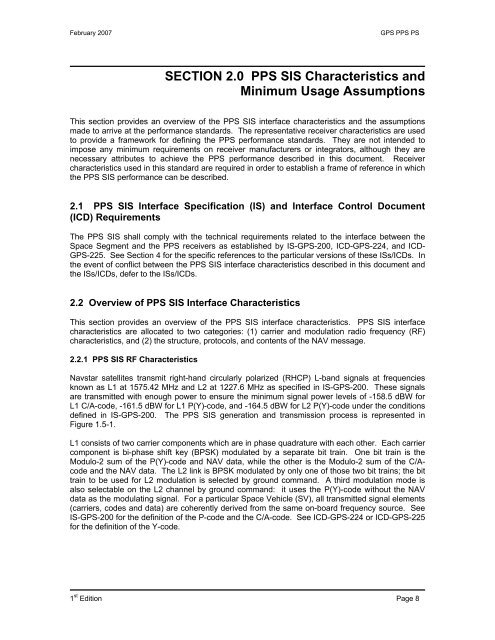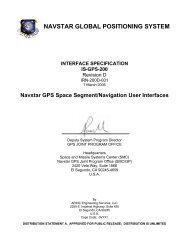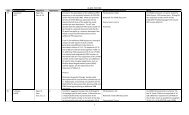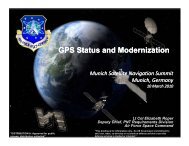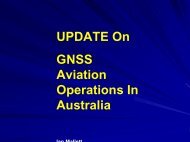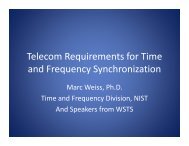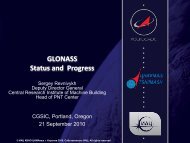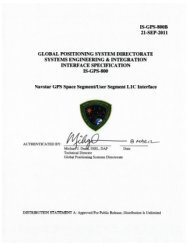Precise Positioning Service Performance Standard - GPS.gov
Precise Positioning Service Performance Standard - GPS.gov
Precise Positioning Service Performance Standard - GPS.gov
Create successful ePaper yourself
Turn your PDF publications into a flip-book with our unique Google optimized e-Paper software.
February 2007<br />
<strong>GPS</strong> PPS PS<br />
SECTION 2.0 PPS SIS Characteristics and<br />
Minimum Usage Assumptions<br />
This section provides an overview of the PPS SIS interface characteristics and the assumptions<br />
made to arrive at the performance standards. The representative receiver characteristics are used<br />
to provide a framework for defining the PPS performance standards. They are not intended to<br />
impose any minimum requirements on receiver manufacturers or integrators, although they are<br />
necessary attributes to achieve the PPS performance described in this document. Receiver<br />
characteristics used in this standard are required in order to establish a frame of reference in which<br />
the PPS SIS performance can be described.<br />
2.1 PPS SIS Interface Specification (IS) and Interface Control Document<br />
(ICD) Requirements<br />
The PPS SIS shall comply with the technical requirements related to the interface between the<br />
Space Segment and the PPS receivers as established by IS-<strong>GPS</strong>-200, ICD-<strong>GPS</strong>-224, and ICD-<br />
<strong>GPS</strong>-225. See Section 4 for the specific references to the particular versions of these ISs/ICDs. In<br />
the event of conflict between the PPS SIS interface characteristics described in this document and<br />
the ISs/ICDs, defer to the ISs/ICDs.<br />
2.2 Overview of PPS SIS Interface Characteristics<br />
This section provides an overview of the PPS SIS interface characteristics. PPS SIS interface<br />
characteristics are allocated to two categories: (1) carrier and modulation radio frequency (RF)<br />
characteristics, and (2) the structure, protocols, and contents of the NAV message.<br />
2.2.1 PPS SIS RF Characteristics<br />
Navstar satellites transmit right-hand circularly polarized (RHCP) L-band signals at frequencies<br />
known as L1 at 1575.42 MHz and L2 at 1227.6 MHz as specified in IS-<strong>GPS</strong>-200. These signals<br />
are transmitted with enough power to ensure the minimum signal power levels of -158.5 dBW for<br />
L1 C/A-code, -161.5 dBW for L1 P(Y)-code, and -164.5 dBW for L2 P(Y)-code under the conditions<br />
defined in IS-<strong>GPS</strong>-200. The PPS SIS generation and transmission process is represented in<br />
Figure 1.5-1.<br />
L1 consists of two carrier components which are in phase quadrature with each other. Each carrier<br />
component is bi-phase shift key (BPSK) modulated by a separate bit train. One bit train is the<br />
Modulo-2 sum of the P(Y)-code and NAV data, while the other is the Modulo-2 sum of the C/Acode<br />
and the NAV data. The L2 link is BPSK modulated by only one of those two bit trains; the bit<br />
train to be used for L2 modulation is selected by ground command. A third modulation mode is<br />
also selectable on the L2 channel by ground command: it uses the P(Y)-code without the NAV<br />
data as the modulating signal. For a particular Space Vehicle (SV), all transmitted signal elements<br />
(carriers, codes and data) are coherently derived from the same on-board frequency source. See<br />
IS-<strong>GPS</strong>-200 for the definition of the P-code and the C/A-code. See ICD-<strong>GPS</strong>-224 or ICD-<strong>GPS</strong>-225<br />
for the definition of the Y-code.<br />
1 st Edition Page 8


